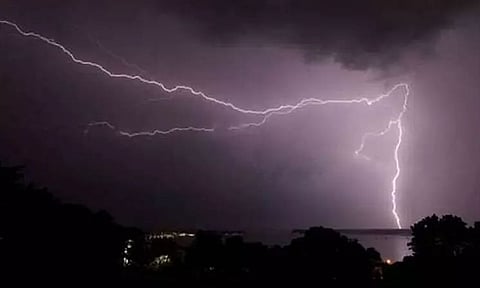
- Home
- Live Blog
- Breaking News
- Top Headlines
- Cities
- NE News
- Sentinel Media
- Sports
- Education
- Jobs

NEW DELHI: Parts of the Indian Peninsula, particularly the Northeast and East, have registered a sharp increase of lightning over the past two decades, while the spike is minimal over the central part of the country and moderate over the rest.
The Indian Institute of Tropical Meteorology (IITM), Pune, an autonomous research and development institution under the Ministry of Earth Sciences (MoES), has established a lightning location network strategically installed at 83 places in the country to detect and locate lightning strikes with utmost accuracy, Union Minister of State (Independent Charge) Science & Technology and Minister of State (Independent Charge) Earth Sciences Jitendra Singh informed the Lok Sabha on Friday.
According to a recent study, with 401 fatalities, Bihar topped the list of lightning deaths from April 1, 2020 till March 31, 2021, followed by Uttar Pradesh with 238 and Madhya Pradesh with 228.
Odisha (156), Jharkhand (132), Chhattisgarh (78), Maharashtra (68), Karnataka (54), Assam (46) and Rajasthan( 42) are the top 10 states to witness lightning deaths for that duration.
A mobile app called 'Damini' has been developed to monitor lightning activities in the skies.
The purpose of this app is to monitor all lightning activities, specifically for India and alerts the person if there are any strikes nearby by GPS notification, in the distance under 20 km and 40 km radius.
The app gives detailed description of instructions and precautions while in the lightning prone area.
The central processor of this network, located at IIT-M, receives and processes the signal received from the network and identifies the location of lightning strikes with less than 500 metre accuracy.
The output from this network is shared with India Meteorological Department (IMD) and various state governments and used for nowcasting purposes, the Minister said.
From the National Weather Forecasting Centre, these forecasts and warnings are given in meteorological sub-divisional scale whereas state Meteorological Centres issue the same to district level.
In addition to that, thunderstorms and associated disastrous weather phenomena are covered by nowcast (forecast for next three hours issued every three hours) in the location/district level by State Meteorological Centres.
At present this facility is extended to all the districts and for about 1,084 stations across the country. (IANS)
Also Watch: